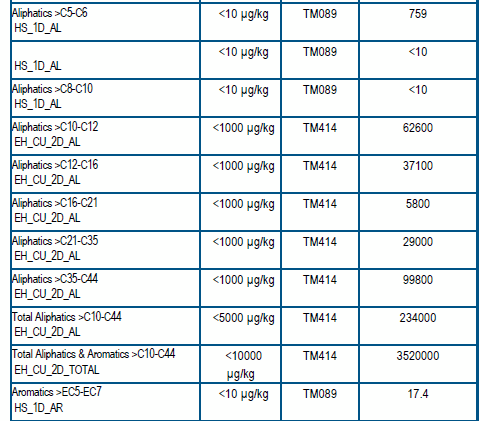Download the HWOL™ Acronym System guide.
All the HWOL™ labs who are certified to publish our .hwol™ files include the hwol™ acronym system, both in their .hwol data delivery files and in the their PDF lab reports. The system will make hydrocarbon test results you receive with terms such as “TPH1”, “EPH”, “mineral oil” etc. more transparent, allowing you to better understand what type of hydrocarbon testing was actually undertaken by a given lab.
The acronyms will feature beside each determinand in both the .hwol file and more importantly, in the PDF report (see example below); this means that even if you receive a PDF report from a third party (i.e. you don’t have a contractual relationship to the test laboratory so can’t ask questions about that data set), you will still be able to understand the type of hydrocarbon testing that was actually undertaken. With this information, you will be better able to assess whether the results are fit for purpose. You will also be able to compare one lab’s results with another….
So what is the challenge with the various hydrocarbon tests being offered by the testing laboratories?
It relates to understanding what the tests actually report; whether they are reporting just petroleum hydrocarbons or both petroleum hydrocarbons and non-petroleum hydrocarbons, such as humic acids in soils or fatty acids in some filter cakes.
Specifically, are the “TPH” results based on everything extracted from your soil, filter cake or sludge by the solvent(s) or has the extract been “cleaned-up” to remove the non-petroleum hydrocarbons. For example, have you ever seen the case where the “mineral oil (C10-C40)” result in the WAC report was of the order of several hundred mg/kg (thus failing inert WAC) while your “TPH-CWG (C6-C40)” result was only a few hundred mg/kg (thus not hazardous)? Shouldn’t the mineral oil concentration be significantly lower or at least more similar to the TPH-CWG result? Or a more recent example (also encountered during the .hwol certification process), where an organic filter cake was tested; here “EPH (C10-C40)” was 500 mg/kg (acceptable), “EPH (C10-C40) cleaned-up” was 100 mg/kg (acceptable), while “TPH-CWG (>C5-C44)” was 1,700 mg/kg ( What ! ).
Depending on which lab the results comes from, these disparities are more easily explained when you understand that the reported concentrations are related to the processing steps that the lab test has actually undertaken. For example, is a lab reporting;
- Everything extracted by the solvent(s) (EH)
- Everything extracted (EH), followed by a clean-up (CU) step to remove non-petroleum hydrocarbons such as the humic acids present in soils
- Whether it is tested using a 1D gas chromatograph or the newer technology: a 2D gas chromatograph (also known as GC-GC or 2D GC-FID)
- Whether the results are a Total (all fractions), or just reflect the aliphatic (AL) or the aromatic (AR) fractions
The embolden text above are examples of some of the components of the HWOL Acronym System (see Table 1). So, for example, the “mineral oil” might be everything extracted, labelled: EH_1D_Total (a big number) or from another lab it might be the result following a specific clean-up step and just the aliphatic fraction; this would be labelled: EH_CU_1D_AL (and be a smaller number). For the filter cake example outlined above, the “EPH (C10-C40) cleaned-up” was EH_CU_1D_Total, while the “TPH-CWG (>C5-C44)” was actually EH_2D_Total, i.e. the larger (unexpected) number was because there was no clean-up stage (and also not following the CWG standard).
Knowing what you are dealing with (especially with labs moving to GC-GC techniques) is critical to:
• A better understanding of all your hydrocarbons
• optimising the waste classification outcome
• passing or failing WAC, and
• for the Phase II engineers, completing accurate human health risk assessments
Figure 1. Example of the acronyms in a Lab Report

Table 1. Examples of the HWOL™ acronyms in a lab report
| Acronym | Description |
|---|---|
| HS | Headspace analysis |
| EH | Extractable Hydrocarbons – i.e. everything extracted by the solvent(s) |
| CU | Clean-up – e.g. by florisil, silica gel |
| 1D | GC – Single coil gas chromatography |
| Total | Aliphatics and Aromatics |
| AL | Aliphatics Only |
| AR | Aromatics Only |
| 2D | GC-GC – Double coil gas chromatography |
| #1 | EH_2D_Total but with humics mathematically subtracted |
| #2 | EH_2D_Total but with fatty acids mathematically subtracted |
| + | Operator to indicate cumulative e.g. EH+HS_Total or EH_CU+HS_Total |
| MS | Mass Spectrometry |
Table 2. Examples of “TPH” determinands (from various labs) and their equivalent HWOL™ Acronyms.
| Terms used in various labs’ PDF reports | Acronyms published in both the PDF Report & .hwol™ file |
|---|---|
| GRO >C5-C10 | HS_1D_Total |
| Aliphatic >C6-C8 | HS_1D_MS_Total |
| EPH Range >C10-C40 | EH_1D_Total |
| TPH1 (C10-C40) | EH_1D_Total |
| TPH (C10-C40) | EH_CU_1D_Total |
| EPH(C5-C40) | EH_CU+HS_1D_Total |
| TPH CWG – Total Aliphatics >C10-C44 | EH_CU_1D_AL |
| Total Aromatics >C10-C44 | EH_CU_1D_AR |
| Total Aliphatics & Aromatics >C10-C44 | EH_CU_1D_Total |
| Total Petroleum Hydrocarbons | EH_2D_Total |
| Total Aliphatics & Aromatics >C10-C44 | EH_2D_Total_#1 |
| Mineral Oil (mg/kg) | EH_1D_Total |
| Mineral Oil >C10-C40 | EH_CU_1D_AL |
| Mineral Oil (mg/kg) | EH_2D_Total |
Note that this system does not try to deal with the efficiency of a particular lab’s preparation steps, their extraction process or their clean-up process. These details should be detailed in their method statements.
